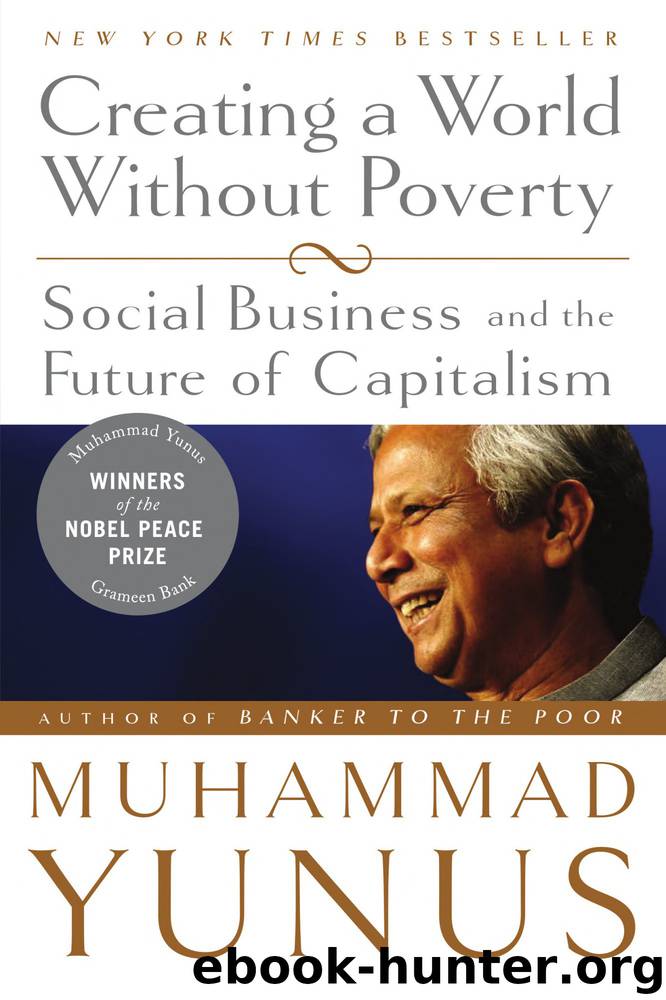Creating a World Without Poverty by Muhammad Yunus

Author:Muhammad Yunus [Yunus, Muhammad]
Language: eng
Format: epub
Tags: sci_culture
Publisher: PublicAffairs
Published: 2011-08-08T21:00:00+00:00
Fortified Yogurt for Children
It was soon clear that Grameen Danone would not start in the baby food business. For Danone, without any experience in Bangladesh, it was too risky at this stage. Babies are very vulnerable to disease, and baby food therefore requires a very strict standard of hygiene. We decided to keep this item in mind for future production.
We agreed that reaching small children was crucially important. And the more we talked, the more we felt that yogurt was the best choice for an initial product. There were several reasons. As a dairy product, yogurt contains many healthful nutrients. The active cultures in yogurt are also beneficial because they promote good intestinal health and help reduce the effects of diarrhea, a deadly scourge in the developing world. Additional micronutrients could be added to yogurt in the form of supplements. And of course Danone was the world’s foremost yogurt maker.
What’s more, yogurt was likely to be a popular food among Bangladeshi children and their parents. It’s creamy and slightly sweet—the kind of food that children the world over appreciate. And there is a local tradition of eating and enjoying yogurt. Under the name of mishti doi (sweet yogurt), it is a popular snack and dessert food, sold in clay pots at local shops or roadside stalls all over the country. However, mishti doi is usually sold for around 20 taka (30 cents), which is beyond the reach of most poor people. If we could produce a fortified Danone yogurt that would appeal to Bangladeshi children—and sell it at a price the poor could afford on a regular basis—we might have a winning product.
So the decision was made: Grameen Danone would be launched with a fortified yogurt product. Later, perhaps, other products could be added. But for now, we would stake our business on yogurt.
Now we had a whole new range of questions to explore. Where would our yogurt factory be located? How big would it be? How could we ensure adequate milk supplies? What marketing channels would we use? What would be the right price for our product?
In one of our first conversations, I made it clear that I was in favor of making the plant as small as technically possible and economically feasible. Emmanuel liked this idea. It coincided with what he called the “proximity business model,” bringing food production, retailing, and consumption as close to one another as possible. He thought this would reduce the cost of the product, too, because strictly local production would mean we could skip the so-called cold chain of distribution that Danone employs in most parts of the world. Daily yogurt products could be sold in the neighborhood within forty-eight hours of its manufacture, eliminating the need for long-distance shipping, refrigerated warehouses and trucks, and other costly distribution measures.
Guy Gavelle, Industrial Director of Danone’s Asia Pacific operation and an expert on safe methods of food production and distribution, was listening intently as Emmanuel and I spoke. Guy had designed facilities in many countries, including China, where he had worked for Danone for eighteen years, and Brazil and Indonesia.
Download
This site does not store any files on its server. We only index and link to content provided by other sites. Please contact the content providers to delete copyright contents if any and email us, we'll remove relevant links or contents immediately.
Hit Refresh by Satya Nadella(8851)
When Breath Becomes Air by Paul Kalanithi(8037)
The Girl Without a Voice by Casey Watson(7599)
A Court of Wings and Ruin by Sarah J. Maas(7245)
Do No Harm Stories of Life, Death and Brain Surgery by Henry Marsh(6683)
Shoe Dog by Phil Knight(4882)
Hunger by Roxane Gay(4676)
A Higher Loyalty: Truth, Lies, and Leadership by James Comey(4546)
The Rules Do Not Apply by Ariel Levy(4520)
Everything Happens for a Reason by Kate Bowler(4474)
Tuesdays with Morrie by Mitch Albom(4390)
The Immortal Life of Henrietta Lacks by Rebecca Skloot(4248)
How to Change Your Mind by Michael Pollan(4112)
Millionaire: The Philanderer, Gambler, and Duelist Who Invented Modern Finance by Janet Gleeson(4089)
All Creatures Great and Small by James Herriot(3980)
Tokyo Vice: An American Reporter on the Police Beat in Japan by Jake Adelstein(3860)
Elon Musk by Ashlee Vance(3852)
Man and His Symbols by Carl Gustav Jung(3843)
The Money Culture by Michael Lewis(3842)
